
9. X-Pigeons |
||||
cr - Crest
The head crest in pigeons was one of the traits proposed by Charles Darwin to have arisen in domesticated populations through many cycles of vigorous breeding by humans. Pigeons are among the most phenotypically variable of all birds, but the wild-type of domesticated pigeons (Columba livia - Rock Pigeon) lack head crests, which normally plays a role in attracting mates in many other bird species in the wild. Today, there are about 350 known domestic pigeon breeds around the World, and more than 80 of these breeds have head crests. The head crest in pigeons is arguably one of the most tested mutants over the last century, yet we still do not fully understand how many genes are responsible for this trait. When tested using the classical (Mendelian) genetics method, it gives many conflicting and varied results, which are probably the reasons why scientists and the breeders became more determined to understand the genetics behind head crest in pigeons. One of the main problems with this mutant was that there was only one genetic symbol (cr) assigned to them assuming they were all caused by a single gene; however, some breeding tests suggested that not all mutants were caused by the same genes. While some tests suggested that the trait was recessive, some results concluded that it was dominant.
The crest trait is an example of a plumage altering mutation causing the feather bud polarity projection on the neck to be reversed in some forms of crests but the degree varies between breeds and even within a breed. Different pigeon breeds display various forms of crest, from a simple peak to a hood of plumage that envelops the head, giving the bird a crown or crest. According to Mangile, if we carefully and thoughtfully examine a peak crest, it becomes quite clear that the feathers on the lower end of the neck and upper back are nearly in their normal position and progressing upward to the back of the head they progressively increase their twisting, angular direction upward and inward - towards the median line from each side of the bird. Mangile points out that feathers involved in a peak crest are not reversed; but they are gradually increasing in their reversal of direction from the back of the neck to the peak. Even the feathers at the summit of the peak are not reversed yet. “However, when we examine a fully expressed shell crest, as in the Komorner Tumbler, we find that the feathers involving the shell portion of the crest are dramatically turned upward. These feathers might be considered "reversed" because they display the "true underside" of the feathers "inside" the shell. Normal neck feathers display an iridescent reddish-green on their surface; and the "outer shell" feathers display an iridescence - implying that the feather has completely been turned into a reversed position at the top of the crest” (Mangile, 1990).

Photo Credit: the pictures (above) were taken from an article named “Genomic Diversity and Evolution of the Head Crest in the Rock Pigeon”, by Dr. Shapiro, et al. (2013) Science vol. 339, p. 1063-1067. From left to right: peak crested Indian Fantail, shell crested Old German owl, mane crested Old Dutch Capuchin, and hood crested Jacobin.
Let us start with the history of all head crests to have a better understanding of what the earlier scientists went through. The earliest mention of the crested pigeons were by Swiss naturalist & bibliographer, Gessner in 1555 (Sell, 2012), and by ornithologist Aldrovandi in 1610 (Sell, 2012). Head crest was also documented by Charles Darwin on “Variation of Animals and Plants under Domestication” in 1868. However, the first genetic testing of the peak crest was reported by J. C. Ewart in “The Penycuik Experiments” in 1899, suggesting that it is a recessive trait - when Archangel and Turbit were crossed with plain-headed birds, the peak crest vanished in F1 (Hollander, 1983). In 1902 J. C. Ewart reported about the hood on “Scientific Transaction of the Royal Dublin Society” that Jacobin mated with a Barb produced a single F1 hen, which had an intermediate hood. When this hen was mated to a Turbit however, two out of nine young were plain-headed (Hollander, 1983). This probably started the confusion about crest being a single recessive trait, i.e., how did two crested parents produce plain-headed offspring? Photo Credit: Peak Crested Archangel picture (below) bred by Carl Spece (picture edited by Arif Mumtaz).
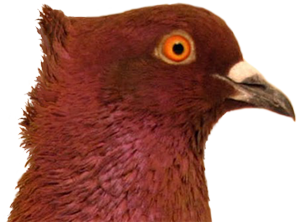 In
1905, Staples-Browne tested the shell crest and produced six offspring
from a Nun hen mated to a Homer cock. The shell
crest behaved as a recessive, when it was recovered in 6 out of 29
F2 birds. However, when the original Nun hen was mated to a Barb cock,
they produced
both crested and plain progeny. Since crest is not known in the Barb
breed, the shell crest being single autosomal recessive became contentious
(Hollander, 1983). In 1911, famous fruit fly geneticist T. H. Morgan,
also studied the shell crest in pigeons. Morgan mated a shell-crested
Swallow cock with a Fantail hen and produced seven F1s all crested;
but in F2's, some of the youngsters were plain-headed. Morgan also
tested
a crested Starling with a Turbit and two out of eight F2 lacked a crest.
Unlike the previous researchers, Morgan concluded that the crest must
be dominant
(Hollander, 1983). In 1911 and 1914, Ghigi in Italy reported that Archangel
x Modena and Bokhara Trumpeter x Chinese Owls showed recessive inheritance
of crest. However, when he mated Chinese Owls with Barbs he got a peak-crested
F1. In addition, when Ghigi mated Jacobin with a Fantail, out of nine
F1s, four had broad shell crest and others had some disrupted feathers
on the side of the neck (Hollander, 1983). Testing results conducted
by different people resulting in controversial dominance of the trait
puzzled scientists. Perhaps there were more than
one type of crest in pigeons, or some of the plain-headed birds used
in these tests were actually
heterozygous
for crest?
In
1905, Staples-Browne tested the shell crest and produced six offspring
from a Nun hen mated to a Homer cock. The shell
crest behaved as a recessive, when it was recovered in 6 out of 29
F2 birds. However, when the original Nun hen was mated to a Barb cock,
they produced
both crested and plain progeny. Since crest is not known in the Barb
breed, the shell crest being single autosomal recessive became contentious
(Hollander, 1983). In 1911, famous fruit fly geneticist T. H. Morgan,
also studied the shell crest in pigeons. Morgan mated a shell-crested
Swallow cock with a Fantail hen and produced seven F1s all crested;
but in F2's, some of the youngsters were plain-headed. Morgan also
tested
a crested Starling with a Turbit and two out of eight F2 lacked a crest.
Unlike the previous researchers, Morgan concluded that the crest must
be dominant
(Hollander, 1983). In 1911 and 1914, Ghigi in Italy reported that Archangel
x Modena and Bokhara Trumpeter x Chinese Owls showed recessive inheritance
of crest. However, when he mated Chinese Owls with Barbs he got a peak-crested
F1. In addition, when Ghigi mated Jacobin with a Fantail, out of nine
F1s, four had broad shell crest and others had some disrupted feathers
on the side of the neck (Hollander, 1983). Testing results conducted
by different people resulting in controversial dominance of the trait
puzzled scientists. Perhaps there were more than
one type of crest in pigeons, or some of the plain-headed birds used
in these tests were actually
heterozygous
for crest?
According to Dr. Cryberg, Show Fantails used
to have peak crests in the early 1900s. Because their standard changed
and called for a plain head - peak crest was more or less eliminated
by the breeders. Still, today a fair number of Show Fantails are heterozygous
for
peak crest so occasionally a peak crested bird is produced. The problem
with discriminating against a recessive trait is that the mutant gene
can
be hidden in the gene pool for number of generations in the heterozygous
state. Therefore, it is possible that some plain-headed Show Fantails
used in breeding tests were actually heterozygous for crest. Some were
likely heterozygous and could produce homozygous peak F1 progeny. Thus,
this could help us
understand
why
crosses of crested birds to Fantails often produced crested F1s. The
case of Barbs being possibly heterozygous for peak is probably a different
situation. Barbs are reliably known to be plain-headed, however that
does not mean that Barbs are not loaded up with genes that contribute
to crest. It is a pure guess at this point but perhaps the Barbs are
actually homozygous for
peak crest but also have some other genetics that suppresses expression of peak
resulting in plain heads. After all, birds homozygous for peak crest are known
to occasionally be plain-headed. Hence, when Barbs are outcrossed to
some
other crested breeds, the suppressing genes in the offspring would
have been altered into a heterozygous state and no longer effective,
allowing a crested phenotype. There are a variety of things that can
impact the expressivity of a mutant gene and so the things mentioned
above for Fantails and Barbs are
simply guesses. But, it seems clear that plain-headed Fantails and Barbs are
not wild-type at the crest loci as their phenotypes might imply (Cryberg,
private communication).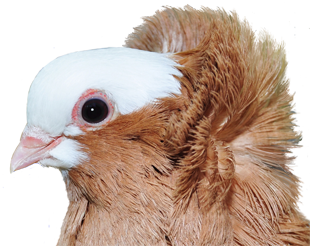
In 1923 Christie and Wriedt of Norway produced extensive number data suggesting that perhaps there were more than one type of crest in pigeons. Based on their findings they have assigned symbols for each: Hood = "Pe", Shell Crest = "ru", and Peak Crest = "cr" (Sell, 2012). Christie and Wriedt produced 80 plain-headed F1 from Petent (old-style Turbit with shell crest) x Danish Tumbler. In F2, backcrosses to Petent produced more than a 3:1 Mendelian scheme and some were peak crests (Hollander, 1983). Two things stand out in their breeding results. Firstly, they recognized the 3:1 ratio did not comfortably fit a single autosomal recessive mutant, yet, they determined that “crest was recessive”. This conclusion was reasonable considering the state of overall genetic understanding in 1925. For a long time, even as late as 1980’s genetics science stuck to this simple idea that most traits were controlled by one single mutant acting all by itself. Secondly, in the Christie and Wriedt’s data there were a fair number of peak crests produced even though no breeds used in the cross were peak crested. After further testing in 1927, Christie and Wriedt concluded that hood was a combination effect of Rundkappe (German word for shell crest - translates as round cap, surrounding the back of the head) symbolized ru, with a modifier Pe (Perucke – German word for extreme feather arrangements of the Jacobin), which is a dominant but only acting when at least one ru allele is present (Sell, 2012). Photo Credit: Bald Head Komorner Tumbler picture (right) is taken by Dr. Michael Shapiro (Picture edited by Arif Mumtaz).
In 1928, more testing in Russia was conducted by Bessmertnaja reported that shell crest and peak crest were both recessive traits (Hollander, 1983). Horlacher at the University of Wisconsin in 1930 reported that peak crested Archangel cross with wild-type showed simple recessive inheritance (Hollander, 1983). Hollander in 1937 tackled the problem as well but could not get the same results as Christie and Wriedt did. He mated a Jacobin cock to a plain-headed mongrel hen that he was reasonably certain was a wild-type for crest. 13 out of 18 young had what he called “broad shell crest”. He reasoned that if Christie and Wriedt’s data were correct, crossing the F1s with broad shell crest with an unrelated homozygous wild-type for crest should give him more crests and partings in the progeny. He produced 55 young, but they were all plain-headed. He wondered where did the Pe (Perucke) go that Christie and Wriedt found, if it was an autosomal dominant (Hollander, 1983). Hollander then decided to make one of the most interesting predicaments in the history of the crest mutant: From Christie and Wriedt, and his own data, Hollander suspected that there was more than one type of crest. So, why he decided to propose a single symbol cr for all types of crest will forever remain a mystery. However, Hollander knew the matter was not closed with the crest mutant, and conducted more testing in 1964. Still getting enigmatic results from Jacobin x English Carrier mating, he decided not to pursue this elusive entity further (Hollander, 1983).
What were these scientists missing or doing wrong in their tests? How were two plain-headed birds able to produce crested offspring, if crest was dominant? Why were plain-headed offspring produced from two crested parents if it was recessive. Although peak crest is ordinarily considered to be a pure recessive mutant, pigeon breeders have raised heterozygous birds that showed at least some crest (Cryberg, private communication) as well as homozygous birds that did not show crest. For instance, in Indian Fantails it is not terribly uncommon to raise a plain-headed young from two crested parents. In one such test of two plain-headed birds that should have been homozygous peak the birds bred as homozygous peak (Kvidera, private communication). Perhaps the two plain-heads used by different testers were different genetically which gave the observed result? Illegitimacy has known to be an issue in Mendelian breeding tests and we have no way of knowing if any of these tests were done in individual breeding cages. In some of the tests, when the tester was talking about a crest, we have no idea what crest he/she was talking about since they have assumed that all crests were controlled by a single gene. Lastly, there seemed to be range of expressivity in both heterozygous and homozygous peak crested birds and this expression varied from molt to molt. All these mysterious breeding results and variety of phenotypic differences in crests had to wait until we had the technology to sequence pigeon's DNA. Photo credits for the pictures below are displayed on the title of each pop-up picture. Click on pictures to enlarge them.




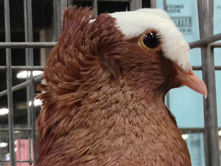
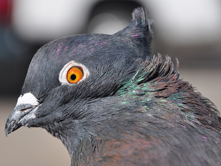
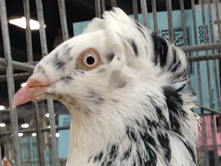
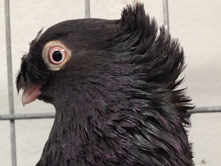
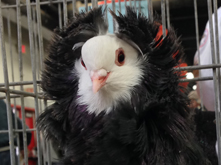
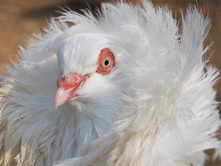
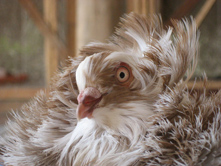
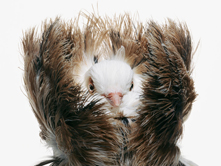
In January 2013, Dr. Michael Shapiro et al. published one of the most extensive DNA studies of the pigeon genome. This paper, “Genomic Diversity and Evolution of the Head Crest in the Rock Pigeon” actually inferred that all kinds of head crests are associated with a DNA mutation in a single gene (Ephrin receptor B2, or EphB2). When Dr. Shapiro’s team tested different breeds of crested and normal headed birds, they found one common mutated gene in all the crested pigeons they tested - EphB2. This mutation by itself appears to be sufficient for a peak crest to form, even in breeds that do not normally have a crest. Formation of other types of crests (shell, mane, hood, etc.) is almost certainly controlled by other genes added to peak. This implies that if EphB2 gene is not mutated or only one mutant copy is present in the genotype, no shell, mane, or hood crest can be seen in the phenotype even if the same bird has all the necessary genes for these crests mutants. If a bird only has two mutated copies of the EphB2, but no other crest genes, then it will show as the peak crest in its phenotype. In other words, EphB2 turned out to be Hollander's cr mutation but this mutant must be present in the genotype in homozygous state for other crest mutants to show up in the phenotype. Therefore, EphB2 is considered to be an epistatic mutation where the effect of one gene masks the effect of others. Thus, even if the bird has the required shell crest genes in its genotype, it may not show any crest it in its phenotype unless the same bird has two mutated copies of the EphB2 gene. Dr. Shapiro and his research team concluded that the EphB2 gene acts as an on-off switch to create a head crest when mutated, and no head crest when normal. On the other hand, mutants that cause shell or mane are considered to be the supplemental mutants to peak - that is, they add to what peak can do all by itself.
This new DNA finding explained a lot of the confusion previously found by the earlier scientists. Although this study did not conclude how many other possible genes were out there at this point, it was clear that the EphB2 mutation permitted a crest to form. Thus, from this study we now know that a bird can have mutations that would potentially lead to development of a shell crest vs. peak crest, etc., but unless it has two copies of the EphB2 mutation that allows the crest to form in the first place, we'll never know if the other crest mutations are present in the genotype. Even though from peak to hood each crest seems to be progressively growing from the back of the head to covering entire neck, with a variety of shapes, and length of the feathers, from this study we also know that peak, shell, mane, and hood were all caused by different genes possibly located in different chromosomes. Therefore, we can conclude that none of the crests are alleles as Shapiro et al. only found a single mutant of EphB2. Furthermore, unpublished breeding data on shell crest indicates that in addition to EphB2 (peak crest) there are two additional genes that act as codominants when peak is homozygous giving a variety of different shapes of shell in different breeds depending on heterozygous or homozygous state of these shell crest genes (Cryberg, private communication). Thus, assigning a single recessive symbol cr for all the head crests does not capture the potential genetic complexity of this trait. Hollander’s observations were consistent with these results as well (Shapiro, private communication). In the 1950 NPA Genetics Booklet, page 22, Hollander wrote, “Crossing tests indicate that all types of crest depends on the main unit difference from wild type". He called the shell and hood crests "modifier genes" (Mangile, private communication).
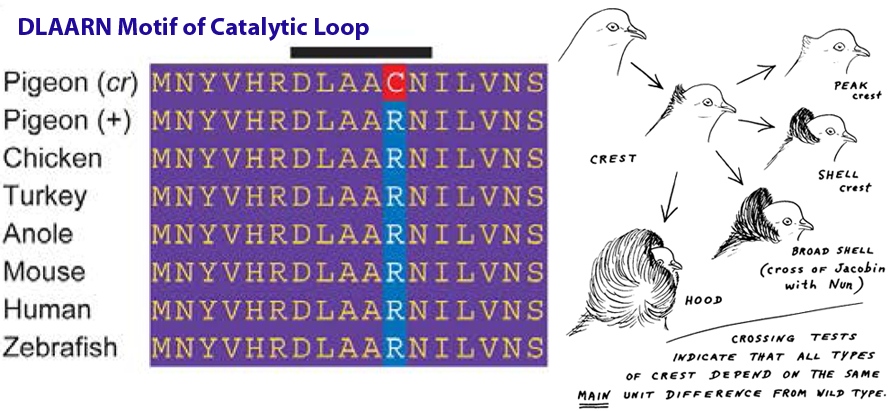
Photo Credit: DLAARN motif of catalytic loop picture (above - left) taken from “Genomic Diversity and Evolution of the Head Crest in the Rock Pigeon”, by Dr. Shapiro, et al. (2013) Science vol. 339, p. 1063-1067. Modifiers Example figure (above - right), presumably drawn by Willard Fisher Hollander taken from 1950 NPA Genetics Booklet, p. 22.
Plain head and neck in pigeons have been chosen to be part of the wild-type (+) phenotype; therefore, like any other unusual feather ornaments around the head and neck, crest is considered to be a mutation. Although the Dr. Shapiro et al. study did not conclude how many other genes are necessary for the shell, mane, and hood crest to be expressed, the mutation found in EphB2 gene is due to single base change in the DNA sequence. This single base change causes the protein to have a different amino acid at a crucial spot. We know the language of DNA consists of four letters (ATC&G), which are called the nucleotides, also known as the base pairs which are Adenine, Thymine, Cytosine, and Guanine. Each word in the language of DNA is made out of a series of three letters, known as the codons – blueprints coding for different amino acids. A series of amino acids, in turn, comprises a protein. At scaffold 612, position 596613 of the pigeon genome (complete DNA sequence), a shift in amino acid from arginine (CGT codon) to cysteine (TGT codon) -- a single base change from C to T -- is what causes head crest in pigeons. If EphB2 is not mutated (CGT), arginine (R) is produced and head feathers will grow normally (wild-type). If however, the EphB2 gene is mutated (TGT), cysteine (C) is produced at this position resulting in at least peak crest in pigeons, unless the same bird has other necessary mutants for shell, hood, etc.
EphB2 gene is an interesting example of how a single letter change can have a profound effect on the phenotype. There are estimated 1.3 billion total base pairs in pigeon’s genome. Yet, one base change in DNA causes crests to form by making the feathers grow up toward the head rather than down along the body. Although there seems to be no difference in gene activity between the crested and plain-headed birds, where and when this feather polarity is established in the embryo, the researchers predicted that the decision to grow a head crest must be made earlier in embryo development. In this study, Dr. Shapiro et al. also showed that the mutation and related changes in nearby DNA of the EphB2 gene are shared by all crested pigeons. Hence, they ruled out the possibility that the mutation arose several times independently in different breeds. Therefore, based on the birds examined in this research, the researchers concluded that EphB2 must have mutated once and then spread to numerous pigeon breeds by cross breeding. In this study, they analyzed 69 crested birds from 22 breeds, and 95 plain-headed birds from 57 breeds.
As you are now aware, trying to sort out epistatic mutants like EphB2 gene by classic breeding experiments was nearly impossible for the earlier scientists. The reason this is so difficult is that when the EphB2 mutant is absent all these other supplemental crest genes probably do not produce a mutant phenotype, even in the homozygous state. This might explain why the earlier scientists studying the crest mutants using Mendelian genetics produced confusing results especially since they were under the impression that a single gene controlled each trait. Recall that in Mendel’s pea plants color of the seed (either yellow or green), form of the seed (either round or wrinkled), height of the plant (either short or tall), etc., were each controlled by a single gene. In addition, earlier scientist did not understand the concept of penetrance of a single gene. A mutant is said to show variable penetrance when that mutant only expresses part of the time. It seems peak crest acts as an incomplete or reduced penetrance since in some cases it has been clearly demonstrated that birds possessing the mutant-associated genotype showed absolutely no manifestations of the condition even in the homozygous state. We now understand why two peak crested parents are able to produce a wild-type (normal headed) offspring due to incomplete penetrance of the peak crest gene. Even though peak crest has been proven to be simple recessive gene in DNA data and most of the time in breeding results, it doesn’t always behave like a simple recessive. For instance, on a number of occasions two peak crested Indian Fantail parents have produced plain-headed offspring. Although some of these plain-headed offspring developed a rudimentary crest at a later age, in their juvenile plumage they were plain-headed. (Cryberg, private communication). However, when these plain-headed F1s are mated back to peak crested birds, 100% of the F2 were peak crested. Modern science calls this phenomenon incomplete penetrance, which is fairly common in the animal kingdom and beyond. Although DNA findings did not completely answer all of our questions and left us with even more puzzles, thanks to Dr. Shapiro and his team we now have a much better understanding of head crest mutants in pigeons.
Acknowledgments:
I would like to gratefully acknowledge the many valuable suggestions and corrections made by Dr. Richard Cryberg, Robert J. Mangile, and Dr. Michael Shapiro and thank them for sharing their extensive experience and knowledge in pigeon genetics. This summary of crest mutation would not have been as sophisticated without the critical suggestions and corrections provided by these experts.
REFERENCES:
1. Cryberg, R. (2014). Private
Communication.
2. Hollander, W. F. (1983). Origins And Excursions In Pigeon Genetics:
A Compilation. Burrton, Kan.: The Ink Spot., P. 90-92. Print.
3. Mangile, R. J. (1990). Are We Winning the War on Whorls?. American
Pigeon Journal. August 1990, Pages 26, 27 & 28.
4. Mangile, R. J. (2014). Private Communication.
5. Kvidera, T. (2014). Private Communication.
6. Sell, A. (2012). Pigeon genetics applied genetics in the domestic
pigeon. Achim: Sell Publ., P. 267-293. Print.
7. Shapiro, M. D. (2014).
Private Communication.
8. Shapiro, M. D., Zhang, G., Huff, C. D., Tan, H., Campbell, M., Pan,
H., et al. (2013). Genomic Diversity and Evolution of the Head Crest
in the Rock Pigeon. Science, 339(6123), 1063-1067.
Copyright August, 2014 by Arif Mümtaz